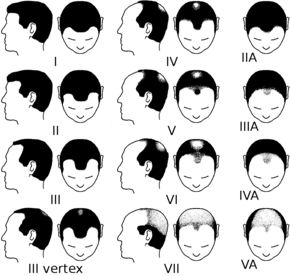Understanding the biology behind hair loss, hair growth and how to treat it.
Hair is made up of strands of dead keratin cells that grow on every area of the skin’s surface except for the palms and soles. It might not be seen by the naked eye, but our entire body is covered in hair, most of which are so fine that they are practically invisible. Hair is made up of keratin, a protein that is produced in the hair follicles located in the skin’s outer layer. Follicles continually produce new cells that cause older ones to push out through the surface layer.
On average, the hair on our heads grows to about six inches per year or 300 micrometers per day. Both adult men and women have a head full of about 100,000 to 150,000 strands and naturally shed around 100 daily.
How does hair grow and why do we lose it?
At any given time, around 90% of the hair on our heads is growing. While every follicle varies in life cycle, certain factors like biological predisposition, age, disease and physiological changes among others are able to affect their natural growth process.
There are four phases of hair growth:
Anagen – The active growth phase of the cycle that lasts between 5 to 7 years for scalp hair and just 4 to 7 months for the eyebrows, armpits and pubic area.
Categen – Referred to as the transition phase that goes on for about 2 to 3 weeks where hair is pushed from the skin and becomes keratinized.
Telogen – This is the resting phase where the length of the hair remains stationary and can last anywhere between 3 to 9 months before cycling back to Anaphase.
Exogen – The shedding phase that causes hair to fall. Strands are detached at the shaft and do not affect the follicles which continue to generate hair.
Hair loss is normal—to a certain extent.
In order to reduce panic over the fear of hair loss, it is important to understand that not every follicle follows the same cycle. A lot of times, the first three phases would have been repeated before shedding takes place, giving rise to a significant amount of loss by the time hair finally falls out. If more strands than usual are left on your brush, don’t be quick to conclude that the loss is severe. You hair just might be following this biological process.
It’s your genes’ fault.
While it was mentioned that a lot of factors could influence the follicle growth cycle, let’s explore the biological predisposition that causes hair loss. This means that even before reaching an old or menopausal age or without contracting a disease, unusual hair loss could happen as determined by a person’s genes.
The biological predisposition for hair loss is called pattern baldness, known scientifically as“Androgenic Alopecia”.
Pattern baldness occurs in both men and women and is caused by a combination of genetic and environmental factors. These external causes are not the root of actual hair loss per se but could significantly promote and worsen the condition.
How does pattern baldness look like?
Hamilton-Norwood Scale
The Hamilton–Norwood scale is used to classify the stages of male pattern baldness. The stages are described with a number from 1 to 7 (Image Source).
Male Pattern Baldness happens when hair follicles shrink due to androgenic hormones. This occurs in over 70% of men and is characterized by a balding temple and thinning at the crown area. Baldness usually begins at the hairline and gradually recedes backward, creating an “M” or horseshoe pattern around the temples.
The Ludwig scale is a method of classifying female pattern baldness (androgenic alopecia), and ranges from stages I to III. (Image Source)
Female Pattern Baldness affects a lesser portion of the population at only 40%. Unlike the receding hairline in men, hair loss starts at the center part in women and gradually widens over time. Noticeable thinning can also be observed around this area and hair loss will consistently be significant in number. Regardless, complete baldness rarely occurs as opposed to that in men, but overall thinning is likely to take place. While most cases begin somewhere between 40 to 60 years old, heredity and unhealthy hair practices can encourage the early rise of symptoms.
A new shampoo won’t do the trick.
A lot of people take hair loss as a case of incompatible hair product use. While it is true that our hair care practices can influence baldness, it should be resolved by more than just switching your shampoo and conditioner.
Because hair loss can also be attributed to a number of diverse factors, people may confuse pattern baldness to occur with stress or diseases when it is actually caused by something else. Attempting to treat hair loss with medications and management procedures gleaned from the Internet and other unreliable sources may even aggravate the condition.
Apart from tracing whether or not pattern baldness runs in the family, the only certain way that you are able to remove the fallen strands from your brush in peace is to seek the help of a medical specialist. This will end any unnecessary anxiety and allow you to treat the hair loss appropriately and effectively.
Dial your way to an effective solution
Different solutions are available, from hair growth pills and topical applications to laser therapy, all of which can be relatively effective depending on the cause of baldness and the patient’s reaction to treatment. To date, the permanent solution for hair loss is hair transplantation. This procedure can effectively restore lost hair and reshape the hairline and is performed as minor surgery with the patient fully conscious throughout the procedure.
Important Links:
https://www.health.harvard.edu/a_to_z/hereditary-patterned-baldness-a-to-z
https://genetics.thetech.org/ask-a-geneticist/balding-genetics
https://ghr.nlm.nih.gov/condition/androgenetic-alopecia
Labels: Hair Loss Tips, Male Hair Loss


















